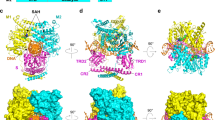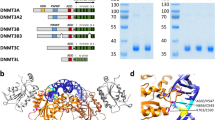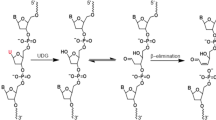Abstract
TYPE III restriction/modification enzymes recognize short, non-palindromic sequences that can be methylated on only one strand, with the paradoxical consequence that during replication of what is in effect hemimethylated DNA totally unmodified sites arise1. Why the unmodified sites are not subject to suicidal restriction was not clear. Here we show that restriction requires two unmodified recognition sites that can be separated by different distances but which must be in inverse orientation. All of the unmodified sites in newly replicated DNA are of course in the same orientation, which explains why they are not restricted. This result may be of relevance to other manifestations of anisotropy in double-stranded DNA, such as genetic imprinting2.
This is a preview of subscription content, access via your institution
Access options
Subscribe to this journal
Receive 51 print issues and online access
$199.00 per year
only $3.90 per issue
Buy this article
- Purchase on Springer Link
- Instant access to full article PDF
Prices may be subject to local taxes which are calculated during checkout
Similar content being viewed by others
References
Bickle, T. A. in Nucleases (eds Linn, S. M. & Roberts, R. J.) 85–108 (Cold Spring Harbor Laboratory Press, New York, 1983).
Klar, A. J. S. Nature 326, 466–470 (1987).
Schroeder, C., Jurkschat, H., Meisel, A., Reich, J. G. & Krüger, D. H. Gene 45, 77–86 (1986).
Krüger, D. H., Bickle, T. A., Reuter, M., Pein, C. D. & Schroeder, C. in Nucleic Acid Methylation (eds Clawson, G. A., Willis, D. B., Weissbach, A. & Jones, P. A.) 113–124 (Liss, New York, 1990).
Hadi, S. M. et al. J. molec. Biol. 134, 655–666 (1979).
van Wezenbeck, P. M. G. F., Hulsebos, T. J. M. & Schoenmakers, J. G. G. Gene 11, 129–148 (1980).
Sambrook, J., Fritsch, E. F. & Maniatis, T. Molecular Cloning: A Laboratory Manual 2nd edn (Cold Spring Harbor Laboratory Press, New York, 1989).
Hadi, S. M., Bächi, B., Iida, S. & Bickle, T. A. J. molec. Biol. 165, 19–34 (1983).
Reiser, J. & Yuan, R. J. biol. Chem. 252, 451–456 (1977).
Meisel, A., Krüger, D. H. & Bickle, T. A. Nucleic Acids Res. 19, 3997 (1991).
Vandeyar, M. A., Weiner, M. P., Hutton, C. J. & Batt, C. A. Gene 65, 129–133 (1988).
Tabor, S. & Richardson, C. C. Proc. natn. Acad. Sci. U.S.A. 86, 4076–4080 (1989).
Author information
Authors and Affiliations
Rights and permissions
About this article
Cite this article
Meisel, A., Bickle, T., Kriiger, D. et al. Type III restriction enzymes need two inversely oriented recognition sites for DNA cleavage. Nature 355, 467–469 (1992). https://doi.org/10.1038/355467a0
Received:
Accepted:
Issue Date:
DOI: https://doi.org/10.1038/355467a0
This article is cited by
-
A transcriptional landscape of 28 porcine tissues obtained by super deepSAGE sequencing
BMC Genomics (2020)
-
Avoidance of recognition sites of restriction-modification systems is a widespread but not universal anti-restriction strategy of prokaryotic viruses
BMC Genomics (2018)
-
SMRT sequencing of the Campylobacter coli BfR-CA-9557 genome sequence reveals unique methylation motifs
BMC Genomics (2015)
-
Structural basis of asymmetric DNA methylation and ATP-triggered long-range diffusion by EcoP15I
Nature Communications (2015)
-
EXPRSS: an Illumina based high-throughput expression-profiling method to reveal transcriptional dynamics
BMC Genomics (2014)
Comments
By submitting a comment you agree to abide by our Terms and Community Guidelines. If you find something abusive or that does not comply with our terms or guidelines please flag it as inappropriate.



